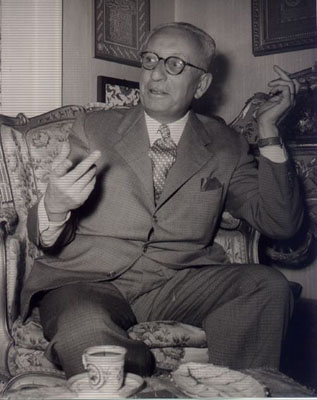The Ekrem Hakki Ayverdi Collection
 The Ekrem Hakki Ayverdi Collection
The Ekrem Hakki Ayverdi Collection
Leading Turkish art historian Professor Semavi Eyice has described Ekrem Hakki Ayverdi (1899-1984) as ‘the man who rescued Ottoman period Turkish architecture from oblivion’, in reference to the scores of historic buildings which Ayverdi restored in Istanbul, Bursa and Edirne, and above all to his eight volume masterpiece on the history of Turkish architecture. The first four volumes cover early Ottoman architecture from the 12th century up to the end of Mehmed II’s reign (1451-1481), and the next four volumes Ottoman works of architecture in the former European territories of the empire. This great work has been described as the title deeds to Turkey’s architectural legacy.
Ekrem Hakki Ayverdi was a scholar who shaped Turkish art history, a dedicated restorator, and also an impassioned collector of traditional art works.
The collection he built up over many years includes inscriptions by the most celebrated calligraphers, gilded copper metalware, opaque twist glass tulip vases and rosewater sprinklers, side tables with the painted decoration known as Edirnekâri work, and silverware marked with the tugra of the Ottoman sultans.
The collection, which is normally kept at Ayverdi’s house on Fevzipasa Caddesi in the district of Fatih in Istanbul, has recently been exhibited at Sadberk Hanim Museum in Buyukdere on the European side of the Bosphorus. As well as calligraphic inscriptions, there are bows and arrows used by calligraphers to strengthen their hands, and writing sets consisting of pen knives, nib sharpeners, pen boxes and ink wells. Ceramics include magnificent 16th century blue and white Iznik ware and wall tiles, and fine examples of 18th century Kutahya ware. In addition there are examples of 19th century Beykoz glassware, Tophane pipe bowls and cups, beautiful spoons, precious 16th century silk brocades and velvets, and antique embroideries.
It has been said that the Kuran was revealed in the Hejaz, read in Egypt and written in Istanbul, in reference to the fact that the art of calligraphy in the Arabic script achieved its aesthetic height in the hands of Turkish calligraphers. In Ayverdi’s collection of calligraphy the truth of this aphorism can be clearly seen.
The collection is the chance to see the work of major calligraphers from the 15th century onwards, such as Seyh Hamdullah, Ahmed Karahisari, Dervis Ali, Hafiz Osman, Agakapili Ismail, Mustafa Rakim, M. Esad Yesari, Kazasker Mustafa Izzet, Abdullah Zuhdi Efendi, Sevki Efendi, Haci Arif, Sami Efendi, Hasan Riza, Hulusi Efendi, Hamid Aytac, Kemal Batanay and Aziz Efendi, in many different script hands.
An illuminated calligraphic exercise in the sulus and nesih hands by Seyh Hamdullah (1429-1519) whose calligraphy ushered in a new age in this art, is not only one of the oldest pieces in the collection, but also an outstanding example of illumination and gilding, while the binding is a masterpiece of laquer decoration. Another masterpiece is an album of calligraphic exercises - temrin - in sulus and nesih by Ahmed Karahisari (?-1556), another calligrapher noted for his innovations. This work demonstrates the brilliance of both his style and composition.
Calligraphic tools and equipment were often works of art in their own right, as we see here with pens and pen knives made of ivory, bone, ebony, jade, mother-of-pearl, coral, agate, agallocum, jujube and rosewood. Some bear the names of the craftsmen who made them, such as Abdullatif, Riza Usta and Fikri. Bone or ivory tablets known as makta used for shaping pen nibs are intricately decorated, as are the porcelain ink wells and graceful paper shears.
The embroideries and textiles in the collection reveal not just the skill, but the creative imagination of the Turkish women who made them. The exhibits dating from the 16th to 19th centuries include fifteen embroidered wrappers, two turban covers, fifteen handkerchiefs, two handkerchief borders, ten napkins, seven handkerchiefs of the type known as cevre, sashes, bands, cloths, Kuran cases, purses, mirror covers, and quilt covers.
One of the oldest ceramics in the collection is a vase dating from the 14th or 15th century with a design clearly influenced by Chinese porcelain. A large blue and white bowl of the type referred to as ‘Golden Horn ware’ characterised by spiral decoration is a rare piece. Ottoman period Iznik tiles dating from the 16th and 17th centuries with classical designs incorporating tulips, carnations, roses, hyacinths, pomegranate flowers and cypress trees, and Kutahya ware in a colour scheme of turquoise, cobalt blue and white are other highlights of the collection.
Exquisitely decorated metalware, wooden objects, mother-of-pearl inlaid mouthpieces for pipes, pen boxes and jewellery boxes are also represented.
This outstanding private collection is a treasure trove of the decorative arts in many fields.
http://www.letsgoturkey.org/information/the-ekrem-hakki-ayverdi-collection.html







